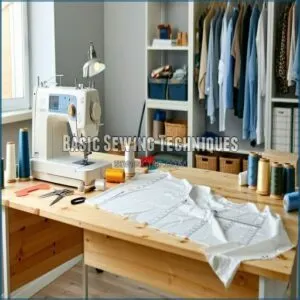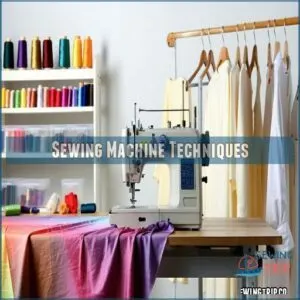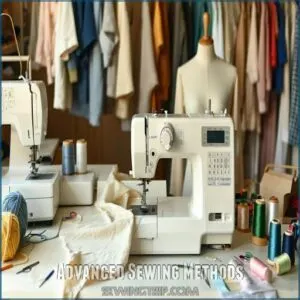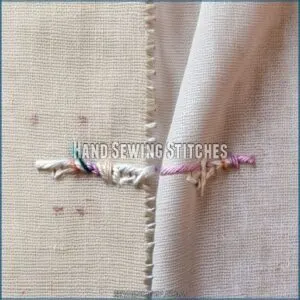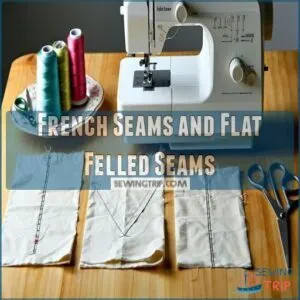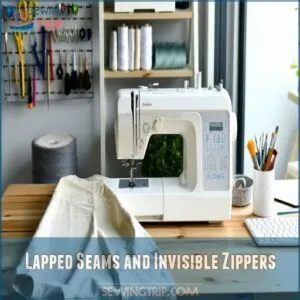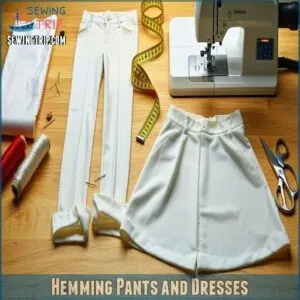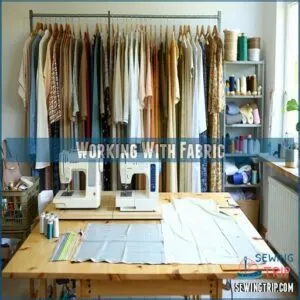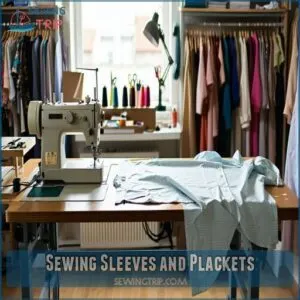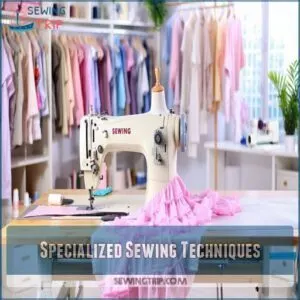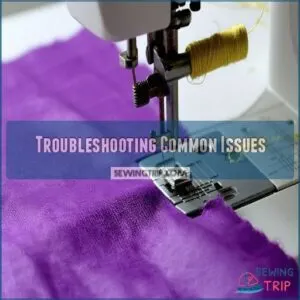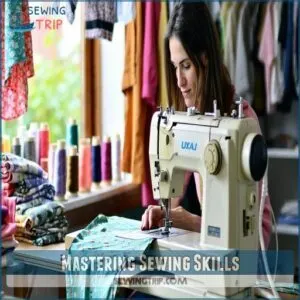This site is supported by our readers. We may earn a commission, at no cost to you, if you purchase through links.

Start with basics like the running stitch and backstitch—they’re your bread and butter for hand sewing.
Machine sewing? Master straight stitching and learn to adjust tension (trust me, it’s a lifesaver).
For a pro finish, try French seams or a zigzag seam to prevent fraying.
Got buttons or zippers to tackle? Precision’s key, but practice makes perfect.
Sewing curves and working with tricky fabrics like knits feel intimidating, but they’re totally doable with the right tools. Ready to take on hems and pockets like a boss? Let’s get stitching!
Table Of Contents
Key Takeaways
- Master the basics like running stitch, backstitch, and machine stitching for a strong sewing foundation.
- Use advanced techniques such as French seams, darts, and invisible zippers to achieve a polished, professional finish.
- Choose the right fabric, thread, and tools to match your project for optimal results and durability.
- Practice on scraps, experiment with embellishments, and refine your skills to build confidence and create standout garments.
Basic Sewing Techniques
Ready to turn your sewing skills from amateur to awesome?
Master the basic sewing techniques that’ll have you transforming your wardrobe like a pro in no time, with hand stitches, machine know-how, and the confidence to create clothes that’ll make everyone ask, "Did you really make that?
Hand Stitches for Beginners
Ready to discover the magic of hand sewing basics? Your journey starts with three killer techniques that’ll transform fabric into art:
- Master the running stitch – your gateway to sewing confidence
- Practice backstitch for rock-solid seam strength
- Learn thread management like a pro
To get started, familiarize yourself with hand stitching techniques to improve your overall sewing skills.
Grab your needle, choose quality thread, and embrace the rhythm of hand sewing techniques.
Your fabric adventure begins now – no machine required!
Machine Sewing Fundamentals
Hand stitching’s charm makes way for machine basics that speed up the process.
Master fabric feeding for smooth sewing speeds and even stitch quality. Focus on thread control to avoid tangles and puckering.
Straight stitching improves with practice and clear sewing machine tips. Create magic by learning these sewing techniques straight from sewing machine tutorials!
| Key Element | What It Means | Why It Matters |
|---|---|---|
| Fabric Feeding | Guiding fabric through evenly | Prevents skipped stitches |
| Thread Control | Managing thread tension | Avoids puckered seams |
| Sewing Speeds | Controlling stitch pace | Improves precision |
| Stitch Quality | Achieving clean, even stitches | Creates professional looks |
| Straight Stitching | Sewing perfectly aligned lines | Foundation of many projects |
Threading a Sewing Machine
Threading a sewing machine might seem like wrestling spaghetti at first, but follow these sewing machine tips, and you’ll master it.
Slide the thread through guides, tackle threading needles, and don’t forget the bobbin management.
Proper thread tension guarantees perfect thread tension and stitch quality.
Watch sewing machine tutorials, maintain sewing speed, and use machine oil to keep everything running smooth.
Choosing The Right Thread
Picking the right thread is like choosing the perfect partner—it makes everything smoother. Here’s the deal: Understanding thread guide is essential for selecting the perfect thread for your project.
- Thread Color Matching: Go darker if unsure; lighter pops too much.
- Fabric Thread Compatibility: Cotton threads for natural fabrics; synthetics love synthetic thread options.
- Thread Weight Selection: Thick threads stand out; thin keeps it subtle.
- Durability: Strong sewing threads handle wear.
- Spool Style Matters: Stack or cross-wound? Match your machine!
Sewing Machine Techniques
Mastering sewing machine techniques makes every project faster, neater, and a lot less stressful.
From keeping stitches straight to using specialty presser feet, you’ll feel like a pro in no time!
Controlling Straight Stitches
Keeping your straight stitch on point takes practice and a bit of finesse.
Start with machine calibration—get that stitch length control just right.
Use both hands to guide fabric, maintaining stability and even sewing speed. Don’t rush; slow and steady wins the race with these sewing techniques.
Pair that with the right thread tension, and you’re golden!
Adjusting Tension Settings
Getting straight stitches isn’t just about alignment—it’s also about mastering tension adjustment. If your sewing machine’s tension is off, expect thread tangling or uneven stitches.
Use these steps for smooth sewing:
- Check your tension meters.
- Adjust sewing calibration gradually.
- Test on scrap fabric.
- Balance top and bobbin threads.
- Keep stitch regulation steady for perfection.
Using Specialty Presser Feet
Think presser feet are just extras? Nope! They’re like secret weapons for sewing.
Zipper feet nail invisible seams, while hem guides keep edges sharp.
Specialty presser options—like quilting or rolled hem feet—transform your sewing machine into a pro tool.
Pair these sewing aids with foot controls and proper tension adjustment for flawless precision.
Master these sewing techniques and elevate your game!
Advanced Sewing Methods
You’re ready to step up your sewing game and tackle projects that look straight out of a designer’s studio.
From sewing zippers flawlessly to mastering tricky curves and working with stretchy or delicate fabrics, these advanced techniques will make your clothes fit and feel amazing.
Attaching Closures and Zippers
Sewing closures like snaps or buttons and attaching zippers can feel like threading a needle—tricky but worth it.
For zipper installation, focus on even stitching and steady hands. Invisible zippers? Align them carefully along the seam for a seamless look.
Button placement matters—mark spots first. Sewing sewing snaps or fasteners? Small stitches keep them secure but flexible.
Understanding sewing fasteners is essential for mastering various sewing techniques and creating professional-looking garments.
Sewing Curves and Corners
If sewing curves and corners feels like wrestling spaghetti, you’re not alone.
For smooth turns and sharp corners, ease your fabric—don’t force it.
Use smaller stitches on tight arcs and snip notches into curved seams for rounded edges that lie flat.
Want pro results? A walking foot helps with curve sewing tips and corner cutting effortlessly!
Working With Knit and Woven Fabrics
Conquering fabric curves is one thing, but fabric selection changes the game.
Knit fabrics stretch, making them forgiving yet tricky—think T-shirts. Woven textiles, like cotton, demand precision due to firmer edges.
Use ballpoint needles for knits and sharp ones for wovens.
Mastering sewing knit techniques is essential for working with these fabrics.
Master fabric manipulation by pinning strategically and handling gently. Sewing fabric types right means fewer head-scratching moments later.
Hand Sewing Stitches
Hand sewing stitches give you the ultimate precision and control that machines just can’t match.
Whether you’re fixing a hole or crafting a custom detail, these techniques are your secret weapon for flawless finishes.
Running Stitch and Backstitch
Ready to power up your sewing basics? The running stitch and backstitch are game-changers for hand sewing techniques.
- Running stitch: Perfect for temporary seams or quick fixes.
- Backstitch: Strong and steady, great for lasting seams.
- Stitch control: Practice steady, even spacing for sewing precision.
Master these basic stitches, and you’ll handle fabric and thread management like a pro!
Ladder Stitch and Buttonhole Stitch
Ladder stitch is your go-to for closing stuffed toys or fixing pillow seams invisibly—think of it as the ninja move of thread control.
The buttonhole stitch? Perfect for sturdy, polished buttonholes or embroidery stitches on jeans or shirts.
Both boost your stitch mastery, whether it’s sewing corners or upgrading seam finishes.
Here’s a handy cheat sheet:
| Stitch | Use | Best For | Difficulty | Look |
|---|---|---|---|---|
| Ladder Stitch | Seam closure | Invisible repairs | Easy | Hidden |
| Buttonhole Stitch | Buttonholes | Embroidery accents | Moderate | Polished & Secure |
| Running Stitch | Quick seams | Basic fixes | Easy | Simple |
| Backstitch | Reinforcement | Strong seams | Moderate | Neat & Tight |
| Satin Stitch | Filling shapes | Decorative embroidery | Hard | Smooth & Bold |
Catch Stitch and Slip Stitch
Mastering the catch stitch and slip stitch takes your hand sewing to pro levels. These stitch variations are perfect for finishing edges and creating invisible hems.
- Catch stitch: Ideal for thick fabrics like wool.
- Slip stitch: Great for sewing invisible hems.
- Hand sewing tips: Keep stitches even.
- Sewing curve techniques: Use slip stitch for flexibility.
- Fabric manipulation: Practice on scraps.
Sewing Seams and Hems
Learning to sew seams and hems is like knowing the secret handshake of professional tailoring—it’s a game-changer.
Whether you’re mastering French seams or hemming your favorite jeans, these skills will make your projects look polished and last longer.
French Seams and Flat Felled Seams
French seams and flat felled seams are your secret weapon for a polished look.
French seams neatly hide raw edges inside two folds—perfect for delicate fabrics.
Flat felled seams, common in jeans, create strong, durable finishes.
Master these sewing techniques by focusing on fabric folding and edge stitching, and you’ll elevate garment assembly and sewing corners with professional results.
Lapped Seams and Invisible Zippers
Ever wonder how to get seams that look clean and zippers that vanish like magic? Lapped seams and invisible zippers are the answers!
- Lapped Seam Tips: Overlap edges for sturdy, flat seams.
- Use Zipper Feet for precision.
- Practice Zipper Installation on scrap fabric.
- Align seams perfectly for Invisible Closures.
- Improve your Sewing Techniques for smooth garment construction.
Hemming Pants and Dresses
Struggling to master hemming? Start with the folded hem technique—it’s perfect for clean pant cuffs or polished dress hems.
Measure the garment length twice; there’s no room for mistakes here. Understanding sewing hem techniques is essential for achieving professional-looking results.
Finish seams neatly to prevent fraying, and press everything for a pro look. Hemming pants and dresses transforms your projects and levels up your sewing clothes techniques like a pro!
Working With Fabric
In the context of fabric, knowing its grainline and properties isn’t just helpful—it’s a game-changer.
Pick the right fabric and add thoughtful touches like bias binding or interfacing to take your projects from “meh” to masterpiece!
Identifying Fabric Grainlines
Grainlines are the compass of fabric orientation—ignore them, and your sewing precision might take a nosedive.
Look for a faint line or arrow on your pattern; it lines up with the fabric grain.
Always align it parallel to the selvage edge. Different fabric types require this step for flawless results—it’s basic textile science meeting pro sewing techniques!
Choosing The Right Fabric Type
Picking the right fabric can make or break your project.
Fabric selection starts with textile analysis—consider fabric weights and uses.
Fiber types like cotton or silk feel different in use, while knit fabrics stretch and woven fabrics hold shape.
Understanding fabric projects is essential for a successful outcome.
Watch those fabric edges—smooth or fraying tells you a lot.
Match fabric types to your project’s vibe.
Applying Bias Binding and Interfacing
Bias binding and interfacing are your secret weapons for polished garment construction.
Bias tape adds seam reinforcement and a clean finish to raw edges, while interfacing methods stabilize fabric for structure.
Want crisp collars or flawless cuffs? That’s interfacing magic.
Mastering these sewing techniques upgrades both clothes repair methods and your professional touch, ensuring every piece looks tailor-made.
Garment Construction
Building a garment is like solving a puzzle—darts, pleats, and linings bring shape and structure while keeping things polished.
Don’t worry, sewing sleeves and plackets might sound tricky, but with a little practice, you’ll stitch them up like a pro!
Creating Darts and Pleats
Creating darts and pleats is like sculpting with fabric, giving garments shape and personality.
For darts, fold and stitch fabric for precise seam shaping—think fitted tops or sleek dresses.
Pleats? They’re all about fabric manipulation and adding flair, perfect for skirts.
Master these sewing techniques to turn flat textiles into expertly crafted clothing that fits beautifully, using techniques like seam shaping.
Adding Linings and Facings
Adding linings and facings takes your garments from homemade to high-fashion. These sewing techniques give structure, smoothness, and polish.
Here’s how to make it work:
- Use linings to hide rough seam finishes and protect fabric layers.
- Attach facings to crisp edges like necklines and armholes.
- Match interfacing types to support facings without adding bulk.
Sewing Sleeves and Plackets
Sewing sleeves and plackets is where garment construction gets real. Investing in a good sewing machine is important to achieve professional results.
Start by easing sleeve caps gently into armholes for that flawless fit. Play with sleeve lengths to customize your look. Experiment with placket styles—classic or edgy, your call. Cuff construction requires precision, but the results wow.
Check this quick guide:
| Task | Tools Needed | Key Tip | Common Issue | Fix |
|---|---|---|---|---|
| Sleeve caps | Pins, sewing machine | Ease fabric evenly | Puckering | Use smaller stitches |
| Placket styles | Sewing gauge, scissors | Mark folds accurately | Misaligned edges | Double-check markings |
| Armhole finishing | Seam ripper, iron | Press seams as you go | Uneven stitching | Sew slower |
| Sleeve lengths | Ruler, chalk | Measure both sides | Uneven hems | Recheck measurements |
| Cuff construction | Clips, needle thread | Fold fabric precisely | Bulky finish | Trim seams carefully |
Specialized Sewing Techniques
You’ve got the basics down, but specialized sewing techniques are where the magic really happens.
From gathering fabric for dreamy ruffles to mastering elastic for a perfect stretch, these skills will take your projects to the next level.
Gathering and Elastic Techniques
Struggling with bunched-up stitches or droopy necklines? Gathering and elastic techniques fix that fast! Tame stretchy knit or create perfect ruffles with gathering methods and elastic thread mastery. To master these techniques, understanding how to elastic is essential for a professional finish.
- Elastic casing keeps elastic secure and comfy.
- Fabric control is easier with proper tension adjustment.
- Sew elastic for a snug fit.
- Stitch gathers evenly.
- Test gathering fabric on scraps.
Mitered Corners and Scallop Edges
Perfecting mitered corners and scalloped edges adds a polished touch to your projects.
Precise fabric folding and sharp cutting techniques are key. For mitered corners, fold at 45 degrees for smooth, clean finishes like pro edge finishing.
With scallop hems, curved seams shine—mark, cut, and sew carefully for that playful, wavy effect. These sewing techniques elevate garment construction methods beautifully.
Sewing With Knit Fabrics
Mastering stretchy knit fabric opens up creative possibilities for comfy projects.
Sewing curves on knit garments can be tricky, but here’s the game plan:
- Use a ballpoint needle—it’s gentle on knit fabrics.
- Adjust your stitch to a slight zigzag for better elasticity.
- Stop fabric stretching by using pins or a walking foot.
Confident stitching starts here!
Troubleshooting Common Issues
When your thread keeps snapping or your fabric puckers like it’s throwing a tantrum, it’s easy to feel frustrated.
Don’t worry—fixing these common sewing headaches is simpler than you think, and soon you’ll be stitching smoothly again, with your fabric behaving as expected.
Thread Breaks and Tension Problems
Frustrated with thread snapping mid-project? It could be tension adjustment, poor thread quality, or even your sewing speed.
Simplify troubleshooting with this table:
| Problem | Possible Cause | Quick Fix |
|---|---|---|
| Thread Breaks | Poor thread quality | Use strong, quality thread |
| Uneven Tension | Incorrect settings | Adjust machine calibration |
| Speed Issues | Sewing too fast | Slow down for smoother sewing |
Keep calm, and stitch on!
Skipped Stitches and Fabric Puckering
Skipped stitches or fabric puckering can turn sewing into a headache fast.
Check your stitch length—too short can mess things up.
Fabric selection matters; lighter fabrics need lighter tension.
Poor thread quality? It’s a culprit too.
Slow your sewing speed when tackling tricky fabrics.
These sewing tips tackle common sewing mistakes, saving you from fighting your sewing machine.
Maintaining a Sewing Machine
You’ve mastered troubleshooting skipped stitches, now keep your sewing machine humming with regular maintenance, including machine cleaning, oil changes, and thread management.
to guarantee sewing machine calibration and prevent future issues, consult a sewing tools guide for tips on machine sewing and threading your machine.
Mastering Sewing Skills
You don’t have to be a pro to sew like one—mastering sewing skills is all about practice and a little patience.
Start with scrap fabric and experiment with stitches until you’re creating pieces that look like they’ve come straight from a boutique.
Practicing on Scrap Fabric
Before tackling big projects, grab some scraps and let loose! Practicing sewing techniques on leftovers is perfect for mastering basic stitches, trial stitches, and even fabric cutting techniques.
Treat it like a playground for sewing drills and Fabric Testing. It’s low-pressure, fun, and great Scrap Management.
Plus, you’ll spot mistakes early—your future (sewing) self will thank you!
Building Confidence and Control
Confidence builds stitch by stitch. Experiment with new sewing techniques, even if they seem tricky at first—it’s how you grow.
Start simple, like mastering straight seams, then step into challenges like precise curves. Pair thoughtful fabric selection with consistent practice to sharpen your sewing fundamentals.
Understanding sewing techniques is essential for achieving professional results. Mistakes? They’re just lessons in disguise. Each project boosts control and sewing precision over time.
Creating Professional-Looking Projects
Ever wonder what separates good sewing from pro-level garment making?
It’s all about fabric selection, seam finishing, and the little garment details.
Add professional trims, smooth out seams with advanced sewing techniques, and practice quality control like your handmade piece is heading down a runway.
Sewing like a pro isn’t magic—it’s mastering these techniques to perfection.
Frequently Asked Questions (FAQs)
What are the 10 types of sewing professionals?
Sewing professionals include pattern drafters, tailors, seamstresses, couture designers, fabric technologists, alteration specialists, embroidery artists, costume makers, industrial sewing operators, and quilt makers—each bringing unique skills to the craft.
How many sewing techniques are there?
There’s no fixed number of sewing techniques since it’s a mix of basics like stitching and seaming, advanced tailoring, and specialized tricks.
You’ve got hundreds to explore, depending on your creativity and project needs!
What are advanced sewing techniques?
Mastering advanced sewing techniques is like discovering hidden levels.
These skills elevate your projects from "meh" to masterpiece.
Darts for custom fits, bias binding for polished edges, sewing curves like a pro, and inserting invisible zippers.
What are the 7 types of stitches?
You’ve got running, backstitch, slip stitch, ladder stitch, blanket stitch, buttonhole stitch, and whipstitch.
These stitches are sewing’s secret sauce for pro-level results. Whether you’re hemming, repairing, or adding flair, each has its charm.
What are time-saving tips for sewing clothes?
Cut patterns in batches to save time, and always pre-thread extra bobbins.
Use a rotary cutter for speedier cuts, and stash a fabric glue stick nearby for those quick fixes—it’s a total game-changer!
How do you choose the best sewing patterns?
Choosing sewing patterns feels like picking the perfect playlist—start with your skill level, match it to your fabric, and verify it fits your style.
Check reviews online for hidden challenges and sizing tips!
What are creative ways to add fabric embellishments?
Spice up your sewing projects with appliqué shapes, embroidered details, or beaded accents.
Try fabric painting or iron-on patches for flair.
Layer lace, ruffles, or ribbons for texture that’s playful, elegant, or totally unique—your call!
How can you recycle old clothes into new designs?
Breathing new life into old clothes is like turning pages in a forgotten story.
Cut denim into trendy bags, transform shirts into crop tops, or patch jeans with bold fabrics—your wardrobe, your rules, endless possibilities.
What techniques work for sustainable fabric options?
Stick to organic cotton, bamboo, or hemp blends—they’re eco-friendly and versatile.
Use French seams for durability, avoid fabric wastage with smart patterns, and repurpose scraps creatively.
Sustainable sewing earns style points and saves the planet!
Conclusion
Picture yourself holding a beautifully sewn garment, every seam crisp, every hem flawless.
With these different sewing techniques for clothes, you’ve got all the tools to transform your wardrobe and bring your creative visions to life.
Whether you’re mastering a French seam or tackling tricky zippers, practice and patience will fuel your progress.
So grab your fabric, thread that needle, and get started—because the journey from beginner to sewing pro starts with just one stitch.
- https://www.pinterest.com/pin/481533385142879323/
- http://takelessons.com/blog/learn-basic-sewing-stitches-z13
- https://www.mygoldenthimble.com/essential-sewing-techniques-you-should-master/
- https://sewing.com/sewing-techniques-sewers-should-master/
- https://sewingtrip.com/basic-sewing-techniques-explained/

